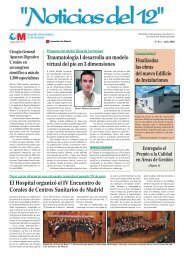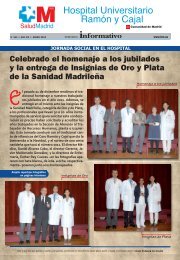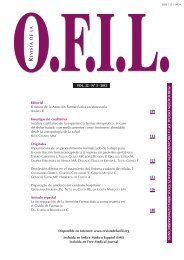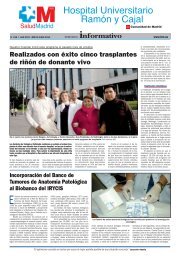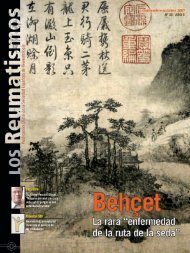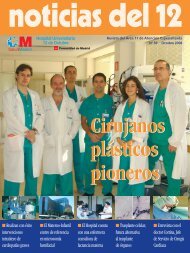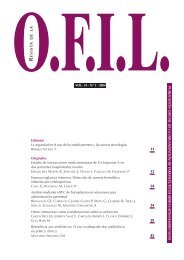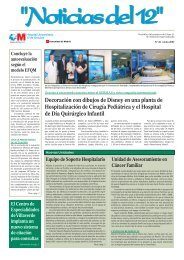Entrevista D. Jesús Pedroche - Sociedad Española de ReumatologÃa
Entrevista D. Jesús Pedroche - Sociedad Española de ReumatologÃa
Entrevista D. Jesús Pedroche - Sociedad Española de ReumatologÃa
You also want an ePaper? Increase the reach of your titles
YUMPU automatically turns print PDFs into web optimized ePapers that Google loves.
24<br />
Documento / Condroprotección<br />
LOS REUMATISMOS / ENE-FEB 2004<br />
MEDIDAS PARA VALORAR EL<br />
EFECTO CONDROPROTECTOR<br />
DE UN FÁRMACO<br />
La medida validada internacionalmente<br />
es la radiografía mediante<br />
imagen digitalizada para calcular el<br />
espacio intrarticular. En concreto<br />
para medir la interlínea <strong>de</strong> la rodilla<br />
una buena alternativa es la radiografía<br />
en posición <strong>de</strong> Schuss (20%<br />
flexión).<br />
Otras formas <strong>de</strong> medir la condroprotección,<br />
no validadas todavía,<br />
incluyen la resonancia magnética<br />
nuclear (RMN), la ecografía, etc.<br />
CONDROPROTECCIÓN Y<br />
CONDROPROTECTORES<br />
La condroprotección es el conjunto<br />
<strong>de</strong> acciones dirigidas a prevenir,<br />
retrasar, estabilizar o incluso reparar<br />
o revertir las lesiones <strong>de</strong>l cartílago<br />
y/o <strong>de</strong>l hueso subcondral. (14)<br />
Un condroprotector es aquel<br />
tratamiento capaz <strong>de</strong> prevenir,<br />
retrasar o incluso reparar las lesiones<br />
<strong>de</strong>l cartílago artrósico humanol.<br />
(2)<br />
ASPECTOS DE LA<br />
CONDROPROTECCIÓN<br />
La condroprotección pue<strong>de</strong> ir dirigida<br />
u orientada a:<br />
■ Prevención<br />
- Protección <strong>de</strong>l cartílago antes <strong>de</strong><br />
su <strong>de</strong>terioro.<br />
■ Tratamiento<br />
- Disminución <strong>de</strong> la velocidad <strong>de</strong><br />
<strong>de</strong>terioro.<br />
- Disminución <strong>de</strong>l dolor y mejora<br />
<strong>de</strong> la rigi<strong>de</strong>z y la movilidad articular<br />
(tratamiento sintomático).<br />
- Regeneración <strong>de</strong>l cartílago dañado.<br />
LA TERAPIA CONDROPROTECTORA<br />
EN EL ARSENAL TERAPÉUTICO<br />
DE LA ARTROSIS<br />
La terapia condroprotectora <strong>de</strong>bería<br />
ser el tratamiento <strong>de</strong> base <strong>de</strong> la<br />
artrosis (tanto en su prevención<br />
como en la artrosis instaurada)<br />
El tratamiento sintomático <strong>de</strong> la<br />
artrosis (Analgésicos, AINEs y<br />
SYSADOA) es necesario y <strong>de</strong>bería<br />
complementar la terapia condroprotectora.<br />
En este sentido, los condroprotectores<br />
<strong>de</strong>berían ser capaces <strong>de</strong><br />
controlar la sintomatología.<br />
Escenarios para valorar la indicación <strong>de</strong> tratamiento condroprotector<br />
1. SINTOMÁTICO<br />
2. SINTOMÁTICO<br />
3. SINTOMÁTICO<br />
4. SINTOMÁTICO<br />
5. ASINTOMÁTICO<br />
6. ASINTOMÁTICO<br />
7. ASINTOMÁTICO<br />
8. ASINTOMÁTICO<br />
FACTORES DE RIESGO SI RX GRADO II/III<br />
FACTORES DE RIESGO NO RX GRADO II/III<br />
FACTORES DE RIESGO SÍ<br />
+ +<br />
FACTORES DE RIESGO NO<br />
FACTORES DE RIESGO SI<br />
FACTORES DE RIESGO NO<br />
FACTORES DE RIESGO SI<br />
FACTORES DE RIESGO NO<br />
RX GRADO 0/I<br />
RX GRADO 0/1<br />
RX GRADO II/III<br />
RX GRADO II/III<br />
RX GRADO 0/I<br />
RX GRADO 0/I<br />
PACIENTES<br />
Los pacientes susceptibles <strong>de</strong> recibir<br />
tratamiento farmacológico condroprotector<br />
para prevenir la artrosis<br />
son todos los que tienen factores<br />
<strong>de</strong> riesgo <strong>de</strong> pa<strong>de</strong>cer esta patología.<br />
Los pacientes susceptibles <strong>de</strong><br />
recibir tratamiento farmacológico<br />
condroprotector para tratar la artrosis<br />
son todos los diagnosticados <strong>de</strong><br />
dicha patología.<br />
Teniendo en cuenta 3 variables<br />
(sintomatología, factores <strong>de</strong> riesgo<br />
y radiología) se pue<strong>de</strong>n plantear<br />
teóricamente 8 diferentes escenarios<br />
en los que se <strong>de</strong>be analizar si<br />
existe evi<strong>de</strong>ncia suficiente para<br />
indicar el tratamiento condroprotector.<br />
Bibliografía<br />
1. Huskinson E.C., Donnelly S.M. Editorial: Hyaluronic acid in<br />
osteoarthritis. European Journal of Rheumatology and<br />
Inflammation 1995; 15 (1): 1-2.<br />
2. Lequesne M., et al. Gui<strong>de</strong>lines for testing slow acting drugs<br />
in osteoarthritis. J. Rheumatol 1994; 21 (Suppl. 41): 65-71.<br />
3. Lequesne M. G. Symptomatic slow acting drugs in osteoarthritis:<br />
a novel therapeutic concept? Rev Rhum (Eng/Ed)<br />
1994; 61: 69-73.<br />
4. Felson DT, Lawrence RC, Dieppe PA, Hirsch R, Helmick<br />
CG, Jordan JM, Kington RS, Lane NE, Nevitt MC, Zhang Y,<br />
Sowers MF, McAlindon T, Spector TD, Poole AR, Yanovski<br />
SZ, Ateshian G, Sharma L, Buckwalter JA, Brandt KD, Fries<br />
JF. Osteoarthritis: New Insights: Part 1: The Disease and Its<br />
Risk Factors. Ann Intern Med 2000; 133(8): 635-46.<br />
5. Carmona L. Artrosis. Estudio EPISER. Prevalencia e impacto<br />
<strong>de</strong> las enfermeda<strong>de</strong>s reumáticas en la población adulta<br />
española. Madrid: MSD y <strong>Sociedad</strong> Española <strong>de</strong> Reumatología;<br />
2001. 61-75.<br />
6. Cooper C, Snow S, McAlindon TE, Kellingray S, Stuart B,<br />
Coggon D, Dieppe PA. Risk factors for the inci<strong>de</strong>nce and<br />
progression of radiographic knee osteoarthritis. Arthritis<br />
Rheum 2000; 43(5): 995-1000<br />
7. Slemenda C, Brandt KD, Heilman DK, Mazzuca S, Braunstein<br />
EM, Katz BP, Wolinsky FD. Quadriceps weakness and<br />
osteoarthritis of the knee. Ann Intern Med 1997; 127(2):97-<br />
104.<br />
8. Gelber AC, Hochberg MC, Mead LA, Wang NY, Wigley FM,<br />
Klag MJ. Joint injury in young adults and risk for subsequent<br />
knee and hip osteoarthritis. Ann Intern Med 2000; 133(5):<br />
321-8.<br />
9. Lau EC, Cooper C, Lam D, Chan VNH, Tsang KK, Sham A.<br />
Factors Associated with Osteoarthritis of the Hip and Knee<br />
in Hong Kong Chinese: Obesity, Joint Injury, and Occupational<br />
Activities. Am. J. Epi<strong>de</strong>miol 2000; 152(9): 855-62.<br />
10. Kujala UM, Kettunen J, Paananen H, Aalto T, Battie MC,<br />
Impivaara O, Vi<strong>de</strong>man T, Sarna S. Knee osteoarthritis in former<br />
runners, soccer players, weight lifters, and shooters.<br />
Arthritis Rheum 1995, 38:539-46.<br />
11. McAlindon TE, Wilson PW, Aliabadi P, Weissman B, Felson<br />
DT. Level of physical activity and the risk of radiographic<br />
and symptomatic knee osteoarthritis in the el<strong>de</strong>rly: the Framingham<br />
study. Am J Med 1999; 106(2): 151-7.<br />
12. Manninen P, Heliovaara M, Riihimaki H, Suoma-Ianien O.<br />
Physical workload and the risk of severe knee osteoarthritis.<br />
Scand J Work Environ Health 2002; 28(1): 25-32.



